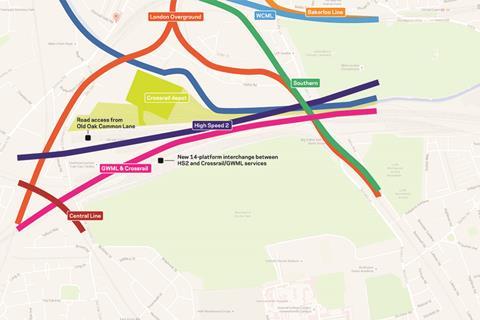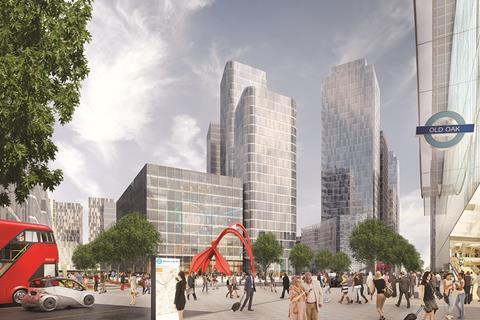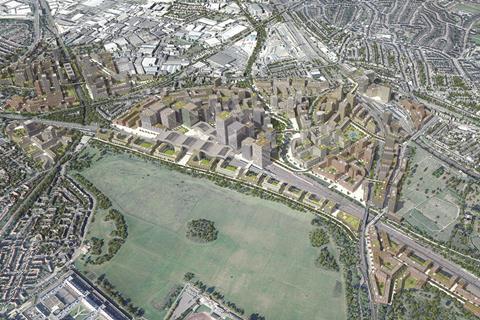A planned interchange between HS2 and Crossrail has made an unassuming spot of west London a candidate for the largest regeneration scheme in the UK. But concerns about the Old Oak Park’s location and a lack of public sector foresight means a site with the potential for 24,000 homes and 55,000 jobs has already run into problems

An unprepossessing piece of industrial and railway land in west London is about to become - according to its promoters - the biggest regeneration scheme in the UK. Yet it’s likely you’ve heard very little about it. The Old Oak and Park Royal Development Corporation (OPDC), set up by former London mayor Boris Johnson in 2015, covers an area almost three times the size of the Olympic park, situated less than three miles from the heart of London’s West End. If realised, it has the potential to deliver 24,000 homes and space for 55,000 jobs in its core development area alone - dwarfing the 10,000 homes planned for the Olympic park.
The reason this previously profoundly unfashionable area has been put firmly on the development map is the decision by the government to put a rail station allowing people to change between Crossrail and HS2 at the heart of it. Architect Terry Farrell, who was the first to investigate its potential five years ago, has said it can be “the next Canary Wharf and Stratford combined”. Former Cabe chair Paul Finch, now chair of the Old Oak Park design panel, says: “We’re talking about the creation of a whole new mini city for London.”
But critics have already raised concerns. Fears abound that the vision is too dense and characterless, that the levels of affordable housing will be too low, that the existing infrastructure will cut it off from its surroundings, and - most worryingly - that a public sector foul-up means the ambitious plans may not be realised at all.
Quick off the blocks
Whatever the concerns, however, you cannot accuse the OPDC of resting on its laurels. Just 15 months after being set up, it has already worked hard to clear up the planning policy for the site, getting an emerging Opportunity Area Planning Framework adopted, and consulting on a draft local plan (which it will be able to implement using its planning powers). Led by energetic former GLA planner Victoria Hills, it has also agreed a memorandum of understanding with the Treasury that will ultimately see the 70% of the core site already in public ownership - mostly held by Network Rail and Transport for London (TfL) - transferred to it. Hills has set out a vision of a high-density piece of new city, built as a sustainability exemplar focused around this transport interchange hub and utilising the industrial heritage of the Grand Union canal which runs through it.

Also in its favour is that the private owner and occupier - used car supermarket Cargiant - of the one major development zone outside of public control, is keen to relocate its primary business and redevelop the site. Working in partnership with developer London & Regional, Cargiant has consulted on a 7,500-home masterplan for what it calls Old Oak Park, will next month issue a further consultation on a refined plan, and aims to submit an outline planning application in the autumn. It has also said it is willing to press ahead with development, if approved, in advance of the Crossrail and HS2 stations being constructed.
However, the area’s core strength - its existing and proposed transport infrastructure, which will put it in easy reach of central London, Canary Wharf and the City - is also its biggest challenge. The site includes two main line intercity railways, a host of local overground lines, a canal and rail sidings, all of which cut off road and pedestrian access. The sheer volume of infrastructure means without serious work to install road and pedestrian bridges and slice through railway embankments, it is, as Old Oak design panel chair Finch says “virtually an island site”. In the London borough of Ealing’s response to the OPDC’s draft local plan consultation, it said: “The whole of this core area is currently cut off from its surroundings in every direction by roads and railways, and this severance is the greatest threat to successful development in all terms; design, social and economic.”
However, infrastructure that is yet to be built poses an even more existential threat to the plans. The core of the development is in a 63ha area of the site known as Old Oak South, which borders on the parkland of Wormwood Scrubs, and which will contain the vast majority of the planned commercial space - enough for 46,000 jobs - as well as space for 6,200 homes, mostly built at high densities of up to 600 homes per hectare.
A request for proposals has been issued but no firm has been appointed yet. Vitally, this site will also contain, from 2026, the HS2-Crossrail interchange, which is the major catalyst for growth in the whole area. The OPDC’s illustrative CGIs show a vision of Canary Wharf-like towers rising up out of the station and surrounding streets. However, OPDC’s Hills has previously admitted that HS2’s provisional station design doesn’t include a development deck to allow commercial construction above the station - something she says would cost “a few hundred million” but would create billions of pounds in development value. She has said she is aiming to influence the government’s decision on the matter now - as the tender for the station design is not due to go out to the market until later this year at the earliest.
This feeds into a wider problem, that of funding the estimated £2bn infrastructure bill required to make the site work. The OPDC has already said it is considering both raising a Community Infrastructure Levy and borrowing against future business rate revenue to pay the bill - but that it is still not likely to be enough. Hills said recently that discussions with government over meeting the gap “are at an early stage and are proceeding positively” - but evidently still far from certain - while the body’s draft local plan says the £2bn bill could rise as “additional infrastructure items emerging from other draft studies and strategies are likely to increase this figure”.

Problems above
However, while there at least remains time to address these problems, even more urgent is the issue in the surrounding land to the north of the proposed station, where Taylor Woodrow/Vinci is near completing a £142m, four-storey, eight-track Crossrail rolling stock depot, designed to accommodate 33 Crossrail trains. In March both Old Oak’s original masterplanner Terry Farrell and former TfL board member Steve Norris raised major concerns over the depot construction for exactly the same reason as Hills is worried about the station itself. They say no provision has been made in its design for any development above the building, let alone for a high density, because when Crossrail’s plans were drawn up no HS2 station was envisaged at Old Oak, and no wider regeneration was planned. Not building on this part of the Old Oak South site would mean, according to reports, that just a few hundred homes could be built, rather than several thousand, and that employment provision would be slashed by a third. Farrell said the issue was “probably the biggest cock-up that I’ve seen in my career of 50 years in London”. Both Farrell and Norris called for an immediate halt to work on the depot while it was redesigned and retrofitted with piling necessary to allow the provision of a deck capable of supporting high-rise over site development.
At the time Boris Johnson’s then chief of staff Ed Lister dismissed the claims, and said that following an OPDC board meeting a TfL proposal to allow over-site development above the depot was being taken forward. Howard Smith, TfL’s Elizabeth line operations director, this week backed this stance in a statement to Building, adding that timely completion of the depot was of “crucial” importance to Crossrail, now known as the Elizabeth line. “TfL has suggested a proposal to add a development deck over the depot in the mid-2020s which it believes is the best way to ensure the Elizabeth line opens on time while maximising the once-in-a-lifetime regeneration opportunity at Old Oak,” he said. “Further work is still to be done on these plans.”
But neither TfL, Crossrail, the GLA nor the OPDC have given any details of how the problem will be addressed, given there has been no pause in construction of the depot.
According to Norris, now partner at strategic adviser Norris McDonough, the problem is far from being fixed. He blames former mayor Boris Johnson for not getting a grip of the issue, despite setting up the OPDC and endorsing the huge headline development numbers.
“There is no plan yet for the decking of the railway lines, which is absolutely vital,” he says. “Despite really pushing the OPDC and Boris [Johnson], all these decisions are now going to land on [new London mayor] Sadiq [Khan]’s desk.”

Getting a grip
The difficulty of addressing the issue is increased because the OPDC’s local plan is not yet approved, and it hasn’t yet appointed a detailed masterplanner for the area, meaning it wouldn’t be clear exactly where piles should be put even if work could be halted. Norris says getting a grip of the issues would mean undoing tens if not hundreds of millions of pounds of public money already invested, and that he has written to Khan’s chief of staff, David Bellamy, to meet with the mayor on the problem. “Bellamy wrote back and said he’d be in touch in due course. Someone will have to take responsibility for this, it may mean delaying the opening date for Crossrail. It’s a huge issue and at some point it will come to the top of Sadiq’s in-tray. The public sector needs to get its act together and get a clear strategy.”
Building understands that TfL’s investigations have shown, despite its public reassurances, that Norris is correct that there is no defined plan to deal with the problem. This is because the building as designed will not be able to hold a development deck capable of supporting more than very limited over site development, even if reinforced. Nevertheless, no-one at City Hall is contemplating ripping up the building - which is mission critical to the running of Crossrail - and thereby delaying the opening of the line. TfL is also understood to have ruled out moving the depot to anywhere other than Old Oak in the future, so engineers are now looking at whether there would be any options for reconfiguring the site later on - but no solution has currently been found. The OPDC and the GLA did not respond to Building’s questions about the impact of the issue on the development plan.
With a project of this scale, numerous difficulties are to be expected, and the boroughs in which the body sits have raised concerns around design, affordable housing, and the plan’s integration with the rest of London. Meanwhile Cargiant - behind the vast and well-received Old Oak Park proposals north of the Grand Union canal - has been engaged in a row with football club QPR, which wants to relocate to the site. Even if this challenge recedes, the OPDC could struggle to get the firm to make the desired early start on development there despite its willingness, as Cargiant hasn’t yet found a site to relocate to. Unless Cargiant is able to find a new home – something it has said will take it until at least 2021 - then nothing can be built in this area either.

Critics of the wider proposals have also raised a bigger point about the scale of development planned, particularly at Old Oak South. While most experts agree the presence of a major transport interchange, such as that planned at Old Oak, means development density can be increased, some are nevertheless baulking at the size of what’s planned. One architect with an involvement in Old Oak, who did not want to be named, said: “It’s not clear how this fits into an overall view of London’s future. The densities are crazy - this has not been put in the public eye enough.”
Certainly, those campaigning against what they see as an excessive proliferation of skyscrapers planned in London, say this is exactly what they are worried about. Architect Barbara Weiss, co-founder of the Skyline Campaign, says: “What has been shown so far looks like construction that could be anywhere in the world. No character, too much glass and steel - just not London. It’s mediocre and uninspirational and it’s a fantastic opportunity currently being missed.” While OPDC has not yet done the detailed work needed to know if this criticism is fair, it points to a risk of development plans driven by a need to pay for expensive infrastructure and hit density targets. When Design Council Cabe landed the deal last September to oversee design quality at the redevelopment Lister said it was proof “that our ambitions to secure world class architecture and exemplar place-making are realised”.
Finch, who remains supportive of the overall approach, says: “The one word of warning to the OPDC is that it’s not enough to just base a whole plan on the basis of providing housing numbers. It should be about creating a fantastic piece of city.”
So far, whether it is a fantastic piece of city, haphazard speculative development, or the current collection of low-rise railway sidings are what is ultimately achieved, it is still very much up for grabs.




























No comments yet